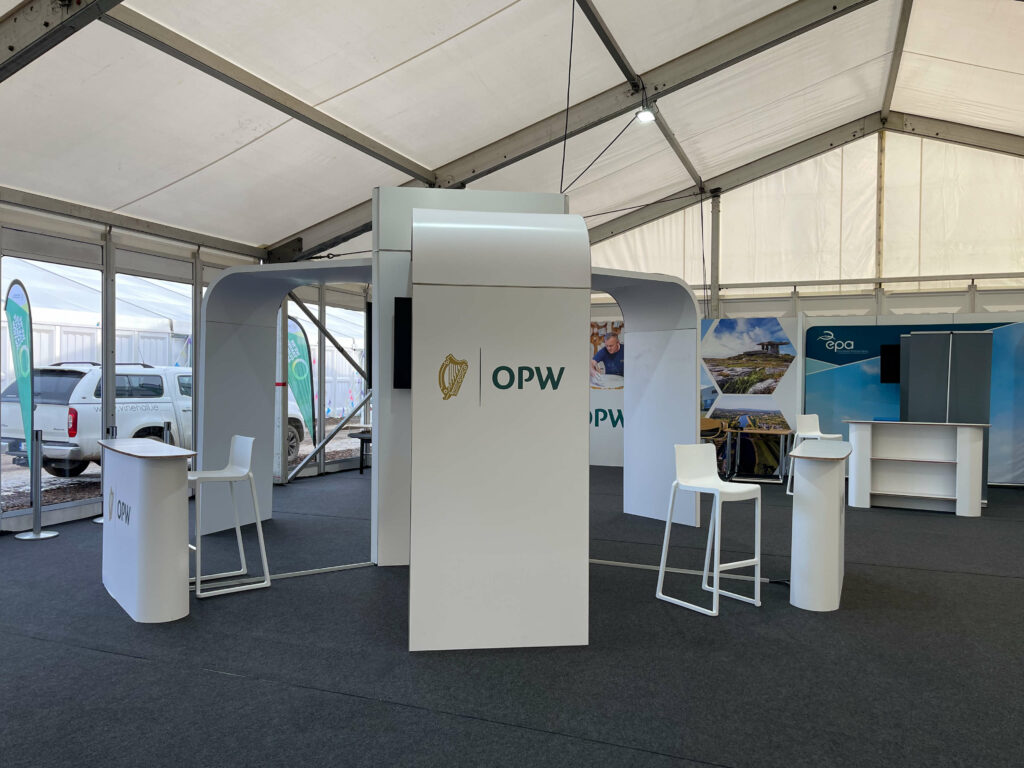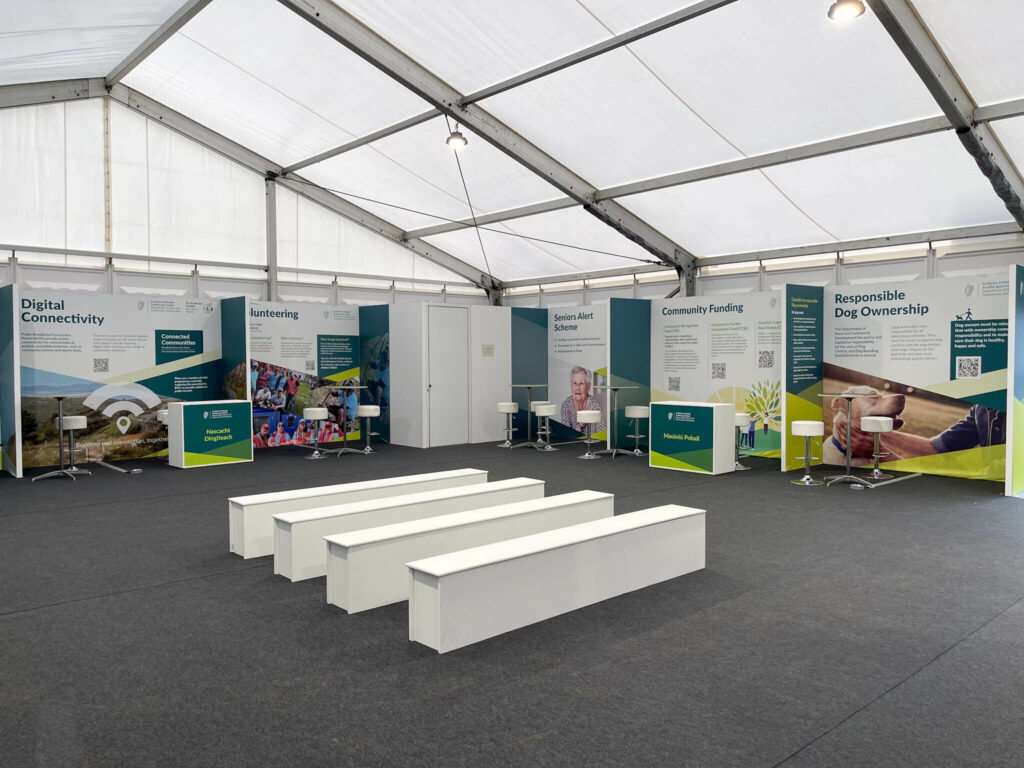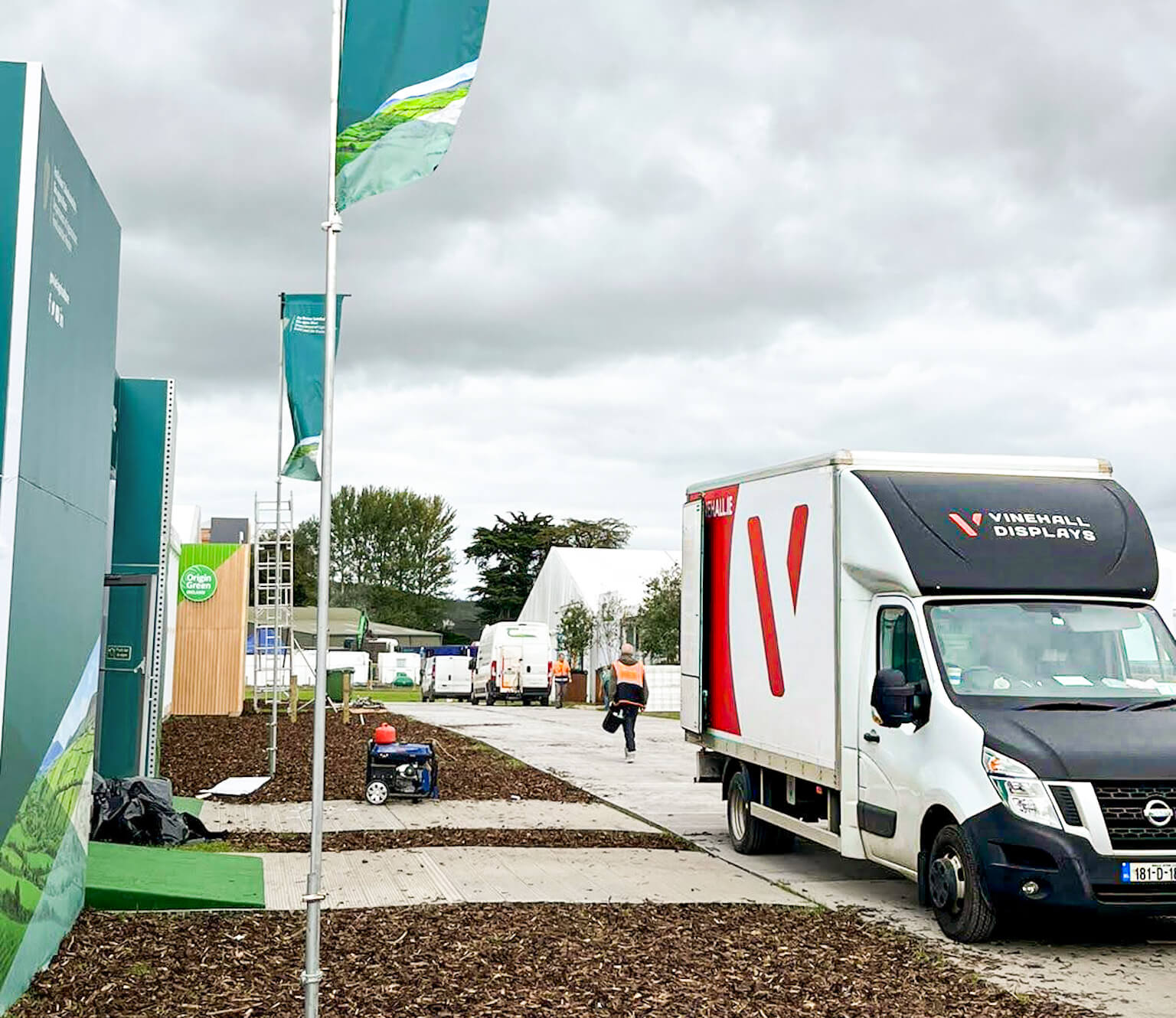Exhibition stands at the National Ploughing Championships offer businesses a prime opportunity to showcase their products and services to one of the largest agricultural (and non-agricultural) audiences in Europe. These stands are a staple of the event, providing a platform where companies from diverse sectors have a huge number of eyes on their brands. From the latest advancements in farming machinery to technology, and a range of non-farming related products and services, the National Ploughing Championships is a prime opportunity for you to showcase your business.
The design and layout of these exhibition stands are critical in capturing the attention of attendees. With thousands thronging the event in Ratheniska, Co. Laois, standholders are tasked with creating engaging and inviting environments that will draw their ideal target in. The goal is not only to attract a large footfall but also to make a lasting impression that could translate into future business opportunities.
With sustainability being a significant concern in modern life, many exhibitors are also adopting eco-friendly practices in their stand designs. This not only reflects well on their brand’s commitment to the environment but also resonates with the progressive mindset of contemporary farmers and agricultural professionals attending the championships. The National Ploughing Championships continues to serve as a pivotal platform for all manners of trade, where exhibition stands play an essential role in the impact on the attendees and their future buying decisions – from B2B and B2C perspectives.
About The National Ploughing Championships
The National Ploughing Championships is one of the most significant agricultural events in Europe, attracting hundreds of thousands of visitors each year. It’s not just about ploughing; the event encapsulates the essence of rural Ireland, featuring livestock, machinery, competitions, exhibitions, and a wide range of entertainment options for all ages. This year, it takes place in Ratheniska, Co. Laois from the 17th of September until the 19th of September, 2024. This is the third year the event takes place at this site, and promises to see over 275,000 attendees over the course of three days.
The event features over 1,700 exhibitors, presenting a wide array of exhibits across various sectors such as energy, forestry, livestock, machinery, construction, agri-business, automotive, home and living, food and beverages, health and wellness, lifestyle and tourism, information technology, business, and education. It’s now one of Europe’s largest outdoor events.
The National Ploughing Championships began in 1931, when ploughing enthusiasts endeavoured to create a competition to determine the best ploughing techniques. Now in its 93rd year, it takes in far more than just ploughing.

Designing Effective Exhibition Stands For The National Ploughing Championships
In the context of the National Ploughing Championships, designing exhibition stands that capture attention and serve the unique objectives of your brand is critical. They should be visually appealing, highly functional, and clearly embody the brand they represent. Think of your experience at other exhibitions – what stood out to you most, and why? This is one of the most important questions to consider when planning your Ploughing Championships exhibition stand.
Aesthetics
The visual appeal of an exhibition stand is the first point of contact with attendees. It’s essential that the design is eye-catching and attention-grabbing – Stands can utilise contrasting colours and effective lighting to stand out amongst competitors and free items and merchandise to draw in footfall. The use of high-quality images and graphics is also advised to create a compelling visual draw.
Functionality
An exhibition stand must be designed with the user experience in mind. This includes considering the flow of traffic through the stand, ensuring there is ample space for demonstrations or interactions, and providing seating for longer conversations, should your brand be that which requires it. Accessibility should be a priority, making sure that all attendees, including those with disabilities, can access and engage with the exhibition stand without impediments.
Branding
The exhibition stand is a physical representation of the brand and therefore must be coherent with the company’s branding strategy. This can be achieved by consistent use of logos, colour schemes, and messaging across all materials on the stand. Exhibitors should strive to clearly communicate their brand values and unique selling points through the design elements of their stand to establish a memorable presence. A good exhibition stand provider will know exactly how to best represent your brand when designing the stand.

Planning and Organisation for Exhibitors
Exhibitors must navigate several crucial steps when preparing for the National Ploughing Championships. They must ensure they understand the procedures for booking space, managing logistics, and adhering to regulations.
Booking Space
Exhibitors should promptly secure their exhibition space by contacting the event organisers. The booking process involves:
- Choosing the appropriate size and location of the stand.
- Completing the official booking form with all required details. Full details of this can be found on the National Ploughing Championships’ website here.
- Submitting the form before the designated deadline to avoid missing out.
Logistics
Arranging logistics requires careful planning to ensure a smooth operation. Navigating the logistical complexities of the National Ploughing Championships, one of Europe’s leading outdoor agricultural events, necessitates careful planning and meticulous attention to detail. Ensuring the safe and timely transport of display materials, equipment, and stands is paramount. This underscores the significance of specialised transport and logistics services.
Providers such as Vinehall Displays bring invaluable expertise to manage the unique demands of such a large-scale event. They focus on seamless coordination of all logistical aspects, from initial planning through to final setup, easing the intricacies involved. Opting for experienced support in this area not only simplifies the process but also enhances the overall impact and efficiency of the exhibition experience, underscoring the critical role of well-organised logistics in the success of any exhibit at the National Ploughing Championships.

Compliance with Regulations
Exhibitors are required to comply with all event regulations:
- Health and Safety: Adhere to guidelines outlined by the Health and Safety Executive (HSE).
- Environmental: Follow waste management and recycling policies. Environmental considerations are now more important than ever. This means ensuring your business and exhibition stand provider is aware and ready to help you fulfil your duties here.
- Stand Design: Ensure the stand meets all structural safety requirements. Choosing a reputable provider will mean that this won’t be an issue.
Engagement and Marketing Strategies
Exhibitors at the National Ploughing Championships harness specific strategies to captivate their target audience and maximise their marketing impact.
Target Audience Attraction
Understanding attendee demographics is essential. Exhibitors should tailor their messaging to resonate with the interests of farmers, agricultural professionals, and rural enterprise owners. Tactics such as:
- Live Demonstrations: Showcasing equipment in action to appeal to practical-minded visitors.
- Expert Talks: Arranging discussions on current agricultural trends attracts those eager for knowledge.
Interactive Elements
Incorporating hands-on experiences ensures visitors engage more deeply with the brand. Examples include:
- Interactive Displays: Using touch screens to simulate machinery operations.
- Product Trials: Allowing visitors to test products fosters a direct connection to the brand’s functionality and benefits.
Promotional Materials
Well-designed promotional items can greatly enhance recall and recognition. Exhibitors should consider:
- Branded Giveaways: Providing useful items like clothing, notepads, or other merchandise.
- Brochures and Catalogues: Detailing product information and services encourages future reference and contact.
Technological Integration
Exhibition stands at the National Ploughing Championships increasingly harness technology to create dynamic and engaging experiences for visitors.
Digital Displays
Digital displays have become a central feature for exhibitors. They utilise high-resolution screens to showcase product tutorials, live demonstrations, and real-time social media feeds. These screens grab attention with their vivid imagery and interactive content.
Social Media Presence
A robust social media presence enables exhibitors to build anticipation before the event and maintain engagement afterwards. Live tweeting, Instagram stories, and Facebook live sessions are common practices that broaden the reach and impact of exhibition stands.
Stand Construction and Safety
In designing exhibition stands for the National Ploughing Championships, particular attention is given to the choice of materials and construction methods to ensure safety and accessibility for all attendees.
Materials Used
- Timber: Exhibitors often use treated wood for framework due to its robustness and ease of assembly.
- Metal: Aluminium and steel are employed for their strength and stability, pivotal in outdoor settings.
- Canvas and Plastics: Weather-resistant fabrics and plastics are selected for covers to protect against the elements.
Emergency Procedures
- Fire Safety: Stands must be equipped with fire extinguishers and clearly marked exits.
- Evacuation Routes: Schematic diagrams display the evacuation routes, posted at multiple locations.
- First Aid: Designated first aid stations are accessible, and staff are trained in emergency response.
Accessibility
- Entrances/Exits: They are designed to be at least 850mm wide to accommodate wheelchairs.
- Ramps: All platforms over 15mm high have ramps with a gradient not exceeding 1:12.
- Surfaces: Walkways between stands are maintained to be firm and slip-resistant to prevent trips and falls.
Post-Event Activities
Post-event activities are crucial for ensuring that the exhibition stands at the national ploughing championships are concluded efficiently and responsibly. They facilitate valuable learning for future events and guarantee that the environmental impact is minimised.
Feedback Collection
Exhibitors typically employ electronic surveys or paper forms to gather feedback from attendees. This data is essential for understanding visitor experience and for exhibitors to measure their performance against objectives. Structured feedback helps identify areas for improvement and success stories to be replicated in future exhibitions.
Dismantling Processes
The dismantling of exhibition stands must be coordinated and systematic to prevent damage and ensure safety. Exhibitors are often given a strict timeline in which to clear their space. They might use checklists to:
- Securely pack merchandise and display materials.
- Label and store equipment for transport.
- Clean the area of any remaining debris.
In this critical post-event phase, the services of a proficient logistics partner like Vinehall Displays can be invaluable. Vinehall Displays offers comprehensive post-event support, including the transport and storage of stands and materials. Our expertise ensures that all elements of your exhibition stand are handled professionally, from the careful dismantling to the secure packing and labelling, followed by the efficient transportation of your assets. Furthermore, Vinehall Displays can provide storage solutions for your stand and materials until your next event, offering peace of mind and continuity.
Waste Management
Efficient waste management is a priority, with an emphasis on recycling and reusing materials. Exhibitors are instructed to:
- Separate waste into recyclables, general waste, and hazardous materials.
- Utilise designated disposal areas provided by event organisers.
These actions significantly reduce the environmental footprint of the event.



